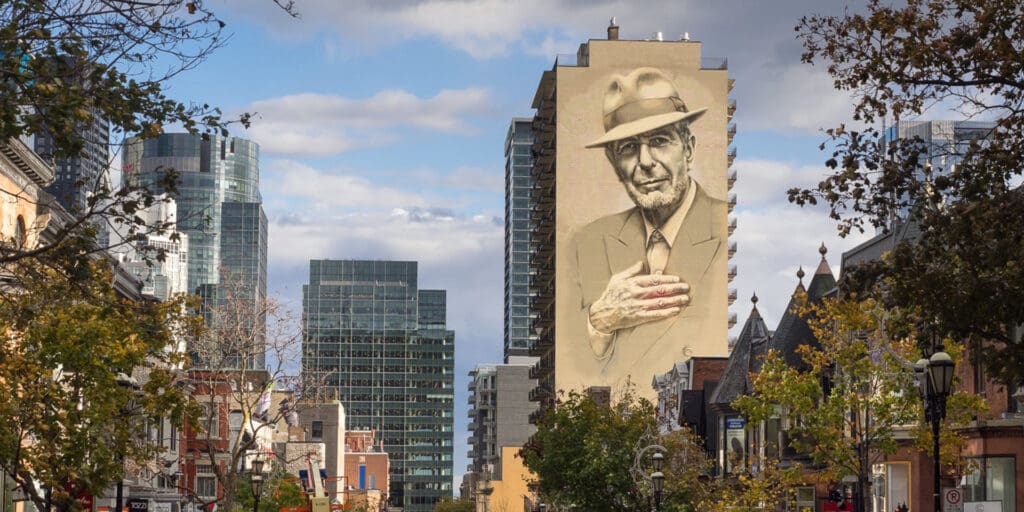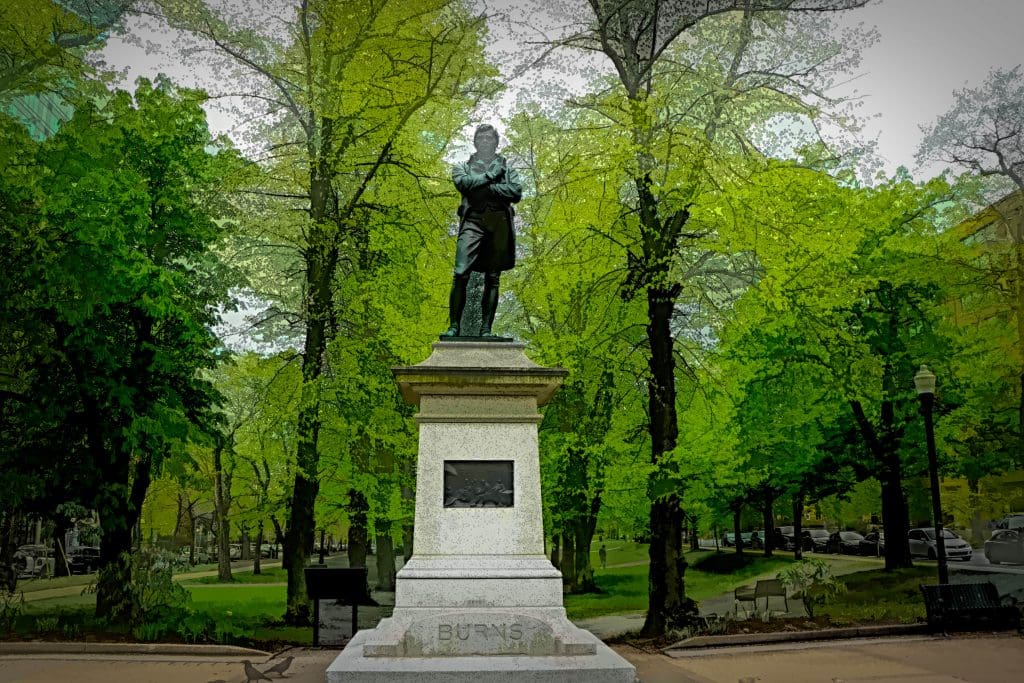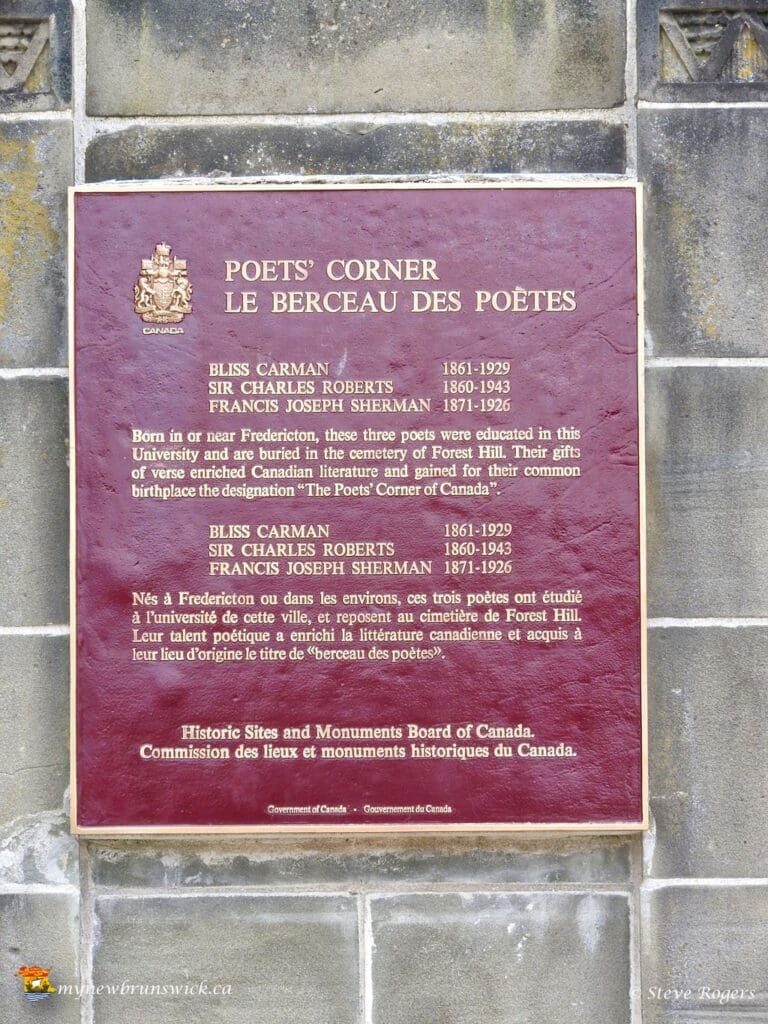Poetic Places to Discover in Canada
by Chloe Coome
for National Poetry Month, April 2020
Poetry is interwoven into the cultural tapestry of Canada and one need only visit to experience its far-reaching influence.
In Montreal, one can go to the Saint-Louis Square and see the Monuments of Émile Nelligan and Octave Crémazie – the first National Poet of Quebec and known as “the Father of French-Canadian poetry”. Or visit the home of Leonard Cohen, where he lived and wrote on Rue Vallières. Then afterwards, take a walk to see the larger than life mural of the famous songwriter-poet, painted on the side of a building. Hand on his chest, the image of Cohen looks out over Crescent Street. In his older years he oftentimes returned to Montreal where residents still share stories of frequent sightings and conversations shared.

In Toronto, Ontario, one can stroll down bpNichol Lane, named for the poet, and discover his concrete poetry etched into the pavement. Or visit Gwendolyn MacEwen park in the Annex remembering the poet and Toronto resident who grew up in High Park and who wrote in both English and Egyptian Hieroglyphics. A streetcar away will take you to the Al Purdy memorial in Queen’s Park, honouring the two-time winner of the General Governor’s Award for Poetry. Outside the Gladstone library rests a Plaque for the poet laureate of Toronto from 2016-2019, Anne Michaels, commemorating her work and engraved with “A Note to the Reader” written by Michaels herself which states “leave a space in your crowded heart/so only the quietest voice can be heard/the space must be small enough for something immense/only the smallest space will do/for ambush/ shut off every device/cry out/ surrender/let love find you”.
Head to west coast Vancouver and spend the day in Stanley Park. Visit the E. Pauline Johnson Memorial, erected in 1992 by the Women’s Canadian Club of Vancouver. Per her wishes, her ashes were scattered among the trees. Johnson also went by the name Tekahionwake. Her father was a Mohawk Chief and her mother an English immigrant; this mixed heritage inspiring many of her poems. Afterwards, one can continue wandering the park, walking to the Robert Burns Memorial, erected in 1928. For those with time to spare a plane ride will take you to Victoria Park in Halifax where another statue of the Scottish poet stands. Or perhaps one would rather enjoy some spoken word. A visit to the Vancouver Poetry House – the largest spoken word organization in Canada where poetry readings, poetry slam championships and a variety of festivals are hosted, is a half hour walk away.

In Red Deer, Alberta sits the Stephansson House, a provincial historic site, where the Icelandic immigrant, Stephan G. Stephansson, lived during the 1800s, farming during the day and writing poetry during the night. Stephansson was known as the Klettafjallaskadið, or “the poet of the Rocky Mountains”. The historic site offers educational programs and a look back into time with costumed interpreters, taking you through the poet’s life and the lives of other pioneers emigrated from Iceland.
In the Yukon, discover the Robert Service Cabin, a historic site where Service wrote. Initially a store clerk in British Columbia, he became known as the “Bard of the Yukon”, writing poetry inspired by the gold rush and the general revelry during the time. In Service’s Poem “The Spell of the Yukon” he writes: “I wanted the gold, and I sought it;/ I scrabbled and mucked like a slave./ Was it famine or scurvy—I fought it;/ I hurled my youth into a grave”.
The cultural presence of Ukrainian Canadians is emphasized by the Ukrainian poets honoured all over Canada. In Winnipeg, Manitoba lies the Markian Shashkevich Park memorializing the Ukrainian poet and priest. In Ottawa and Winnipeg there are monuments honouring Taras Shevchenko. Considered one of the greatest Ukrainian literary figures of all time, he was an outspoken activist for Ukrainian independence.
In Fredericton, New Brunswick, one can find the The Poets’ Corner of Canada. Visit the plaque in front of the Harriet Irving Library at the University of New Brunswick honouring Bliss Carman, Sir Charles G.D. Roberts and Francis J. Sherman; all influential poets from Fredericton who are buried in Forest Hill Cemetery. They were known for their poetry greatly inspired by Canada and its various landscapes.

Canada abounds with places to feel and experience poetry as it helps to shape a landscape and its people. From visiting monuments and wandering through parks, taking a plane ride and listening to words spoken, there is much to enjoy if you know where to look.
